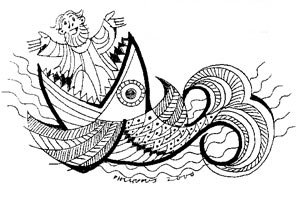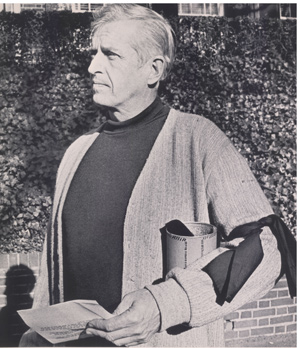

Peacemaking: Images from Jonah House Archive 1967-1973
#1. PHIL BERRIGAN POURING BLOOD An astonished Selective Service attendant looks on. A second attendant eyes Phil even as she holds Tom Lewis with gentle restraint. Other participants in “The Baltimore Four” were the Reverend James Mengel and David Eberhardt . “How do we move from dissent to resistance?” The question was in the forefront of consciousness among anti-war activists of the 1960s. As they watched the young refuse induction and go to prison, the question became critical: “What about us? How can we encourage them if we ourselves are not willing to share in their risk?” “The Baltimore Four” was the first of more than 100 draft board actions across the country that spanned the years of 1967 – 1972. The inspiration for the action came from a family in Minnesota long in conflict with our nation's warring. They saved the family fecal matter until they had what they considered an adequate supply. They then took said matter to their local draft board and poured it on the draft records. It has been named “the movement that began a movement!” In their trial in Baltimore , all four participants were convicted. Philip and Tom were sentenced to 6 years in prison; David to 2 years; and Jim Mengel to probation and mandatory psychiatric counseling.
|
|
|---|---|
#2. TOM MELVILLE , PHILIP AND DANIEL BERRIGAN It was four in the first action; at Catonsville the number grew to nine. Philip Berrigan and Tom Lewis acted again this time with Daniel Berrigan, S.J., Tom and Marjorie Melville, John Hogan (the latter three recent Maryknoll Missioners in Guatamala), Mary Moylan, George Mische and Brother David Darst, a Christian Brother from St. Louis, MO. The nine walked into a Catonsville draft board office, carried about 600 1-A files in wire baskets out to the parking lot and burned them with homemade napalm. The incident gained national attention and became a play on Broadway called "The Trial of the Catonsville Nine." A shared conviction that the United States ' military actions in Vietnam were illegal and immoral inspired them. The statement released by the group read, in part: "Our apologies, good friends, for the fracture of good order, the burning of paper instead of children, the angering of the orderlies in the front parlor of the charnel house... We could not, so help us God, do otherwise… ." The Catonsville case garnered significant national and international media attention because Catonsville was a quiet, middle-class suburb of Baltimore - not exactly a hot-bed of radicalism - and because the participants were not stereotypically bedraggled and bearded student activists. After a political trial, authorities convicted each of the nine of federal crimes and sentenced them to prison terms of between one and three years. Five of the " Catonsville 9," as they had come to be known, opted to "go underground" rather than submit to incarceration. The controversies caused by the protest helped galvanize the national anti-war movement. They also underscored the way political action, no matter how historically important it becomes, often begins with the actions of a few courageous "ordinary" people. Lynne Sachs ' 2002 documentary, "Investigation of a Flame," provides a meditation on the protests of the Catonsville 9. Relying primarily on both rare archival footage and recent interviews with several participants, her film probes the political and spiritual bases of the incident and places it within the larger context of the War in Vietnam and anti-war activism at home. 
|
|
#3 PHILIP BERRIGAN ARRESTED BY FBI AGENTS Appeals of their conviction having run out, the Catonsville 9 were ordered to report to the U.S. Marshals to be delivered to Federal Prison on April 9, 1970 . Five of them refused; the war had become more violent, more deadly and wider. How to continue their protest? Philip and David Eberhardt went underground in NYC. They were scheduled for a “surfacing rally” at St. Gregory the Great Church on West 95 th St. in NYC. Because Dan Berrigan had, a couple of days earlier, escaped the waiting FBI at a celebration at Cornell University in Ithaca, NY, there was no way the FBI would allow the rally to go forward. They broke into the rectory and made their arrests early that afternoon. Philip and David began their prison term immediately.
|
|
#4 DANIEL BERRIGAN ESCORTED BY FBI AGENTS Dan Berrigan continued to avoid arrest for more than four months. All the while he would appear at rallies, at churches preaching, doing interviews with press, keeping the news of the raging war before the minds of the America people. FBI learned through a stoolpigeon of Dan 's presence on Block Island with long time friends, William Stringfellow and Anthony Towne . In the midst of nor'easter, there they were acting as “bird watchers” until they caught sight of Daniel . The photo was taken after a ferry crossing in rough waters. The FBI appear to have suffered from the crossing a great deal more than Dan .
|
|
#5 PHILIP BERRIGAN ESCORTED FROM LEWISBURG FEDERAL PRISON TO STAND TRIAL IN HARRISBURG , PA. There was little doubt that Philip was held at the maximum security prison in Lewisburg in deference to the FBI's continued search for his brother Daniel . It was during this time of prison that the FBI informant and provocateur “befriended” Philip and used his status as a student (leaving the prison daily to study at Bucknell University) to garner information and to weave a web around people he knew to be friends of Philip – all as a basis for the celebrated Harrisburg Conspiracy Prosecution in 1972.
|
|
#6 JESUIT PRIESTS, DANIEL BERRIGAN AND NED MURPHY , DEMONSTRATE OUTSIDE ST. PATRICK 'S CATHEDRAL IN NYC 1972 was a difficult year for people opposed to the War in Indochina . (No longer could we rightly name it the Vietnam War. War had expanded into Laos and Cambodia .)
|
|
#7 DANIEL BERRIGAN AND NED MURPHY “Where is the Church?” Catholic opposed to the war and the killing had to wrestle with a Church that blessed the war makers and the killers. On a number of occasions circles would gather, as pictured here, across the street from Churches to celebrate a liturgy on repentance and inclusion. They concluded that perhaps the only place for them was “on the margins” of the institution. There they strove both to be the Church they longed for and to challenge the institutional Church to live the Gospel that it proposed to preach. Often, as pictured here, that stance appealed to the young people who felt excluded by institutionalized religion.
|
|
#8 PHILIP BERRIGAN PROTESTS OUTSIDE THE GEORGETOWN HOME Henry Kissinger , then National Security Advisor to President Richard Nixon, was responsible for keeping the War in Indochina raging as well as threatening the use of nuclear weapons against North Vietnam at the Paris Peace Talks. Two months earlier, he was behind the overthrow of the democratically elected President Allende in Chile in a brutal coup orchestrated and backed by the U.S. CIA and NSA. Round-the-clock vigils at his home were part of an effort to summon Kissinger to act decently and responsibly.
|
|
#9 LIZ MCALISTER, FRIDA AND PHILIP BERRIGAN , NOVEMBER 8, 1974 How do we sustain nonviolent resistance to a criminal state? The answer was in community where people learn together to live differently from the systems of domination that are at the heart of the filthy rotten system that has spawned so many wars, so many injustices. Communities like Jonah House call people to: In nonviolent community, people step out of one world where violence is the ultimate solution and into another where the spiral of violence is broken by those willing to absorb its impact with their own flesh.
|







